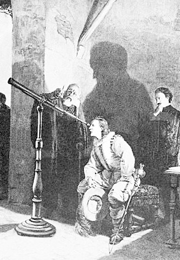E-Archive
Off the Beaten Track
in Vol. 7 - July Issue - Year 2006
Crystalline Spheres

“Could this be?”, the middle-aged man muttered under his breath as he squinted into the eyepiece. His sharp nose and thick beard were barely discernible in the cold winter night. He scurried to check his notes by the light of the oil lamp placed at a distance from the telescope, so that its light would not interfere with his observations. Grunting impatiently as he flipped through the documents, he could find no mention of what he could now see clearly through the instrument he had painstakingly built with his own hands. “Four errant stars, unknown and unobserved by anyone before us”, he would later write in a book describing his discovery.
When, in the summer of 1609, Galileo first heard about a curious gadget which had been developed in Holland, he immediately realized its potential. The monocular, as it was first called, was said to make objects appear much closer than they actually were. Early models gave a magnification of about three times and poor resolution. As soon as he understood the basic concept of the device, and without actually seeing the Dutch invention, Galileo went about designing and building his own model. He made precise calculations for determining the most suitable shape of the lenses and their ideal position and distance in the tube, personally grinding and polishing the glass. Progress was rapid: his first model, built in July, was three-powered but one month later had already passed to eight-powered. By November 1609 he had perfected a twenty-powered model which he used for his first serious observations of the sky.
During that same winter, he made drawings of the surface of the Moon showing details no one had ever seen before. A few weeks later, on that cold January night in 1610, he trained his telescope on Jupiter and quickly realized that the “four errant stars” next to that planet were in fact orbiting moons.
Other stunning observations ensued. He saw that the planets were actually disks and not merely points of light like other stars in the sky. Venus had phases, just like the Moon. Saturn appeared to have bumps near its surface which he mistook to be companion stars; in fact they were the outline of the rings which encircle that mighty planet. The sun was in constant ebullition, with mysterious dark spots moving across its surface. The Milky Way was actually a concentration of an incredible number of stars and not a cloud of “cosmic vapor” as previously thought.
At the beginning, not all of Galileo’s observations could be corroborated by other astronomers, whose inferior telescopes did not allow them to see what he saw. Critics claimed that he had invented his data and, realizing that he risked being isolated, he quickly built and sent copies of his telescope to various royal courts in Europe and to others who had been taking part in the growing debate.
But what, exactly, was the nature of this debate? Aristotle, the Greek philosopher who lived four centuries before Christ, said that motion on Earth is in straight lines, whereas motion in the heavens is always circular and uniform. Stars rested on gigantic crystalline spheres revolving around the Earth, which stood perfectly still. His views were commonsensical elaborations of what he observed around him. Did not a stone drop down to the ground in a straight line? Did not each crystalline sphere silently move its star in a perfect circle above the Earth? Life on Earth was chaotic and often unpredictable, but the heavens above were perfect and never changed. Other ancient philosophers had offered opposing theories, but the means by which to prove them did not exist. Aristotle was right simply because he exposed his thoughts clearly and in a more convincing manner. Physics was staunchly rooted in the realms of philosophy and rhetoric, and remained so for many centuries afterwards, even when it was dragged into later theological debates.
Galileo’s observations vindicated the many thinkers who, over the centuries, had intuited the fallacies of the ancient theories. The rotation of the planets, the existence of moons around them and the revolution of the planets around the sun shattered forever the old order upon which the universe had been built.
Over his lifetime, Galileo built one hundred telescopes and managed to achieve a magnification of about thirty times. Although he considered only ten of these pieces good enough to be used for his astronomical studies, he had shown others how to look at the sky through new eyes.
By Giovanni Gregorat, Contributing Editor MFN & Sales Manager, Pometon S.p.A.
Author: Giovanni Gregorat


























